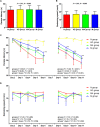Manual Acupuncture Regulates Behavior and Cerebral Blood Flow in the SAMP8 Mouse Model of Alzheimer's Disease
- PMID: 30766475
- PMCID: PMC6365452
- DOI: 10.3389/fnins.2019.00037
Manual Acupuncture Regulates Behavior and Cerebral Blood Flow in the SAMP8 Mouse Model of Alzheimer's Disease
Abstract
Background: A growing body of evidence has demonstrated that cerebrovascular function abnormality plays a key role in occurrence and worsening of Alzheimer's disease (AD). Reduction of cerebral blood flow (CBF) is a sensitive marker to early perfusion deficiencies in AD. As one of the most important therapies in complementary and alternative medicine, manual acupuncture (MA) has been used in the treatment of AD. However, the moderating effect of MA on CBF remains largely unknown. Objective: To investigate the effect of MA on the behavior and CBF of SAMP8 mice. Methods: SAMP8 mice were randomly divided into the AD, MA, and medicine (M) groups, with SAMR1 mice used as the normal control (N) group. Mice in the M group were treated with donepezil hydrochloride at 0.65 μg/g. In the MA group, MA was applied at Baihui (GV20) and Yintang (GV29) for 20 min. The above treatments were administered once a day for 15 consecutive days. The Morris water maze and arterial spin labeling MRI were used to assess spatial learning and memory in behavior and CBF respectively. Results: Compared with the AD group, both MA and donepezil significantly decreased the escape latency (p < 0.01), while also elevating platform crossover number and the percentage of time and swimming distance in the platform quadrant (p < 0.01 or p < 0.05). The remarkable improvement in escape latency in the MA group appeared earlier than the M group, and no significant statistical significance was observed between the N and MA group with the exception of days 5 and 10. The CBF in the prefrontal lobe and hippocampus in the MA group was substantially higher than in the AD group (p < 0.05) with the exception of the right prefrontal lobe, with similar effects of donepezil. Conclusion: Manual acupuncture can effectively improve the spatial learning, relearning and memory abilities of SAMP8 mice. The increase in CBF in the prefrontal lobe and hippocampus could be an important mechanism for the beneficial cognitive effects of MA in AD.
Keywords: Alzheimer’s disease; MRI; Morris water maze; behaviors; cerebral blood flow; hippocampus; manual acupuncture; prefrontal lobe.
Figures


 P < 0.01,
P < 0.01,  P < 0.05 compared with the N group.
P < 0.05 compared with the N group.  P < 0.01 compared with the AD group.
P < 0.01 compared with the AD group.


Similar articles
-
Benign Regulation of the Astrocytic Phospholipase A2-Arachidonic Acid Pathway: The Underlying Mechanism of the Beneficial Effects of Manual Acupuncture on CBF.Front Neurosci. 2020 Feb 4;13:1354. doi: 10.3389/fnins.2019.01354. eCollection 2019. Front Neurosci. 2020. PMID: 32174802 Free PMC article.
-
[Effect of electroacupuncture on cyclin-dependent kinase 5 and Tau protein in hippocampus of SAMP8 mice].Zhen Ci Yan Jiu. 2020 Jul 25;45(7):529-34. doi: 10.13702/j.1000-0607.190752. Zhen Ci Yan Jiu. 2020. PMID: 32705825 Chinese.
-
Effects of manual acupuncture combined with donepezil in a mouse model of Alzheimer's disease.Acupunct Med. 2019 Feb;37(1):64-71. doi: 10.1136/acupmed-2016-011310. Epub 2019 Mar 7. Acupunct Med. 2019. PMID: 30843424
-
Efficacy of acupuncture in animal models of vascular dementia: A systematic review and network meta-analysis.Front Aging Neurosci. 2022 Aug 18;14:952181. doi: 10.3389/fnagi.2022.952181. eCollection 2022. Front Aging Neurosci. 2022. PMID: 36062145 Free PMC article.
-
A Review on Characteristics of Experimental Research on Acupuncture Treatment for Alzheimer's Disease: Study Design.Evid Based Complement Alternat Med. 2022 Jul 9;2022:8243704. doi: 10.1155/2022/8243704. eCollection 2022. Evid Based Complement Alternat Med. 2022. PMID: 35855822 Free PMC article. Review.
Cited by
-
Olfactory Three-Needle Electroacupuncture Improved Synaptic Plasticity and Gut Microbiota of SAMP8 Mice by Stimulating Olfactory Nerve.Chin J Integr Med. 2024 Aug;30(8):729-741. doi: 10.1007/s11655-023-3614-3. Epub 2023 Nov 24. Chin J Integr Med. 2024. PMID: 37999886
-
Roles and Mechanisms of the Protein Quality Control System in Alzheimer's Disease.Int J Mol Sci. 2021 Dec 29;23(1):345. doi: 10.3390/ijms23010345. Int J Mol Sci. 2021. PMID: 35008771 Free PMC article. Review.
-
Effect of acupuncture on brain regions modulation of mild cognitive impairment: A meta-analysis of functional magnetic resonance imaging studies.Front Aging Neurosci. 2022 Sep 23;14:914049. doi: 10.3389/fnagi.2022.914049. eCollection 2022. Front Aging Neurosci. 2022. PMID: 36212046 Free PMC article.
-
Electroacupuncture could balance the gut microbiota and improve the learning and memory abilities of Alzheimer's disease animal model.PLoS One. 2021 Nov 8;16(11):e0259530. doi: 10.1371/journal.pone.0259530. eCollection 2021. PLoS One. 2021. PMID: 34748592 Free PMC article.
-
Mechanisms of comorbidity between Alzheimer's disease and pain.Alzheimers Dement. 2025 Feb;21(2):e14605. doi: 10.1002/alz.14605. Alzheimers Dement. 2025. PMID: 39998175 Free PMC article. Review.
References
-
- D’Hooge R., De Deyn P. P. (2001). Applications of the Morris water maze in the study of learning and memory. Brain Res. Brain Res. Rev. 36 60–90. - PubMed
LinkOut - more resources
Full Text Sources
Research Materials

